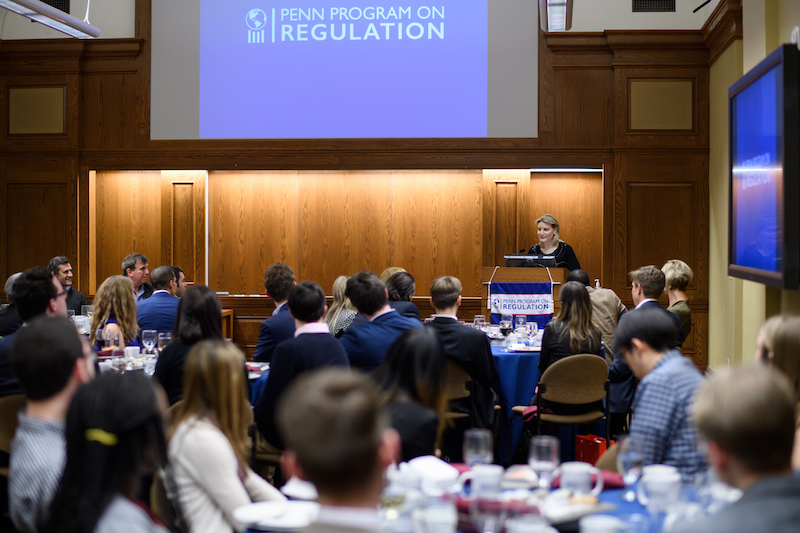
This publication’s new name and newly designed website constitute a significant step forward, in furtherance of its mission of public service.
Regulation traces back to at least Mesopotamia in 1754 BC, but its importance to society is hardly ancient history. Ever since the global financial crisis, just a decade ago, regulation undeniably has occupied a central spot on policy agendas around the world. A flurry of still more recent events around the globe have only solidified regulation’s location on society’s front burner, including Britain’s “Brexit” from the European Union and a string of hotly debated Trump Administration executive actions aimed at reshaping the U.S. administrative state.
Against this backdrop, students at the University of Pennsylvania Law School have for the past seven years edited a daily, online publication—originally known as RegBlog—that provides in-depth but accessible coverage of regulatory issues confronting decision-makers throughout the world. This publication, sponsored by the Penn Program on Regulation, constitutes a distinctive platform for the dissemination of balanced news coverage and rigorous analysis of regulatory research and policy developments. It also facilitates the expression of the full range of policy perspectives as a means of advancing key policy discussions over regulation.
Today, this publication takes a significant step forward toward fulfilling its mission of public service. In an effort to promote public understanding even more meaningfully, as well as to advance the thinking of both policy decision-makers and regulatory scholars, we have changed our publication’s name to The Regulatory Review and have launched a newly designed website. These changes will give us a better ability to communicate our mission and capitalize on the features that have long set us apart among publications.
The reliability, accuracy, and relevance of the writing that this publication features remains our top priority. The name RegBlog never fully communicated that priority or reflected the careful judgment and extensive effort that our editorial teams put into selecting and preparing essays for publication each business day throughout the year.
In an age in which too many publications sell splash and sensationalism, The Regulatory Review holds fast to publishing well-reasoned and responsibly produced content. We put the “public” first in “publication.”
Operating with a new name and web platform, we stand as committed as ever to providing the best regulatory coverage by leading scholars, public officials, policy advocates, and members of our staff. In a world concerned more than ever about the ugly proliferation of “fake news,” the need for and value of institutions like ours, committed to providing credible information and a balanced array of viewpoints, seems more important than ever.
In addition to ensure the reliability and balance in our coverage, we remain committed to making the regulatory world as transparent to our readers as we can. Our hallmark over the last seven years has been to break down complex regulatory issues into clear, digestible forms, without losing precision or accuracy. That is no easy task. But it has led us to tackle what might seem, at first glance, to be obscure topics.
Several years ago, for example, this publication covered the controversy surrounding “incorporation by reference”—a practice by which government regulators insert into public law the requirements of codes developed by industry groups and other nongovernmental entities, without stating exactly what those requirements say. Members of the public and regulated entities must at times pay expensive fees to purchase private, and copyrighted, rules that become binding in public law. Congress has at least tacitly encouraged this practice, under the theory that privately developed codes will be better informed and more cost-effective than rules written by government regulators. Yet incorporation by reference also raises important questions about governmental transparency and the degree of public protection that private standards can provide.
Just as this publication helped our readers understand the complexities of incorporation by reference, it has shed light on numerous other complex regulatory issues of today, including the rise of the sharing economy, the benefits and costs of benefit-cost analysis, the role of technology in the regulatory process, and solutions to the problem of regulatory capture by special interests, to name just a few. As the topic menu at the top of our new website makes clear, the world of regulation encompasses a broad range of issues involving business, education, the environment, health, infrastructure, international affairs, legal and political processes, rights, and technology.
Across all these areas, the world not only needs credible, accessible information about regulation, but also neutral spaces where differing viewpoints can be aired fully but respectfully. The broader field of regulation especially needs such spaces, as the policy terrain over regulation remains especially contested. Contestation stems, no doubt, from the nature of regulation itself. As much as regulators ideally aim for so-called Pareto outcomes that make some people better off without making anyone else worse off, in reality regulation inevitably produces both winners and losers, beneficiaries and cost-bearers. Regulation also inevitably implicates society’s most deeply held values—liberty and equality, safety and efficiency, democratic politics and scientific expertise—that frequently come into conflict with each other.
Despite value conflicts and uncertainties, regulatory decisions must be made, even when the smartest decision in some circumstances might be to wait or create no regulation at all. Both policymakers and the public can learn when differing views receive a fair and full airing. Through the process of open expression, policy differences might even narrow. At least the stakes can be defined more clearly so that varying sides can understand each other.
We are proud to have featured over the years a diversity of disciplinary perspectives and a broad range of voices across the ideological spectrum. Just in the past year, we have published essays on regulatory capture by both Democratic Senator Elizabeth Warren and Republican Senator Mike Lee. We have devoted space for an exchange of views over benefit-cost analysis between regulatory advisors to President George W. Bush and a board member of the Center for Progressive Reform. We have also recently highlighted a diverse set of viewpoints about regulating the use of force by police officers in the United States.
In addition to delivering public value through our distinctive deliberative venue, the student-run nature of The Regulatory Review will keep it serving as a training ground for society’s future leaders. Running an ongoing publication requires staff members to learn constantly about new regulatory issues. It gives them day-to-day practice in the teamwork, communication skills, and professionalism that they will need to confront new challenges throughout their careers and to keep working for the betterment of society.
The Regulatory Review now has a new name and new website. But its heart and soul remain the same. Perhaps now more than ever before, we hold steadfast to our mission of excellence, accessibility, and neutrality. With a new name and platform, we have strengthened the foundation upon which Penn Law students will be able to keep achieving that mission for many years to come.





